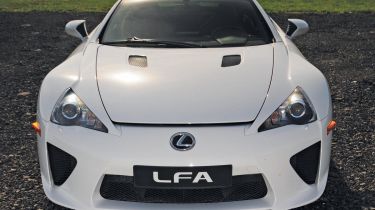Lexus LFA
How does first ever Lexus supercar shape-up?
The LFA project was originally conceived in 2000 as a Research and Development exercise… but the idea grew into a single-minded quest to develop a car that pushed the boundaries of technology and performance to the limit. The result is a machine quite unlike anything ever to have worn a Lexus badge before.
[[{"type":"media","view_mode":"content_narrow","fid":"78023","attributes":{"alt":"","class":"media-image"}}]]
For all of its high-performance potential, the firm’s engineers certainly haven’t been in a rush. The first prototype appeared in 2003, before a concept made its debut at the Detroit Motor Show in 2005. After that, Lexus test drivers spent years working in the world’s toughest locations. As a result, the LFA had a very public development and the sense of anticipation was huge by the time the production car was launched at last year’s Tokyo Motor Show. So has it been worth the wait?
A quick look at the spec sheet is enough to see where the development hours and money have gone. The high-revving V10, composite chassis, auto transmission and optimised aerodynamics make the LFA a road car that’s been created with the fanatical attention to detail that’s normally exclusive to top-level motorsport vehicles.
It looks the part, too. Winglets, vents and intakes show how the appetite for downforce influences styling in this sector. The carbon fibre-reinforced plastic body panels are tightly sculpted over the composite chassis and the LFA is a dramatic presence wherever it goes.
Used - available now

2019 Ford
Fiesta Vignale
44,100 milesManualPetrol1.0L
Cash £10,500
2022 Volkswagen
ID.3
33,043 milesAutomaticElectric
Cash £13,500
2023 Audi
e-tron
50,934 milesAutomaticElectric
Cash £18,900
2022 Dacia
Duster
49,300 milesManualPetrol1.0L
Cash £11,100Inside, Lexus hasn’t abandoned its luxurious roots. As you would expect for a car costing nearly £340,000, the cabin is hand-built and beautifully finished. The seats are superb, while forged aluminium pedals and a flat-bottomed wheel contribute to a near perfect driving position and ergonomics.
But any concern that the LFA would be sanitised by the usual Lexus strengths of comfort and refinement is dispelled by the burble of its mighty V10 engine. Co-developed with Yamaha, it wails with a high-pitched exhaust note. And it takes on an even more manic persona between 7,000rpm and the 9,000rpm limit. With 552bhp and 480Nm of torque – 90 per cent of which is available from 3,700rpm – performance is scintillating, while the positive throttle response and six-speed automated manual gearbox add to the race car feel.
The transmission doesn’t have the seamless changes of more modern double-clutch units, but there are seven shift speeds to choose from. At its fastest, there’s a brutality to every upshift that suits this car’s no-compromise feel.
The chassis impresses, while a large spoiler rises automatically at the rear and helps to deliver genuine downforce, adding to the levels of mechanical grip. High-speed stability is reassuring, while fast steering and powerful ceramic brakes ensure the LFA feels at home on the track. On the road the conventional suspension is firm but well damped, so it copes
admirably with bumpy surfaces.
With its old-fashioned gearbox, the LFA isn’t perfect, and it’s certainly expensive, but you can sense the effort that has gone into creating this machine. It’s a beautifully built technological extravagance.







